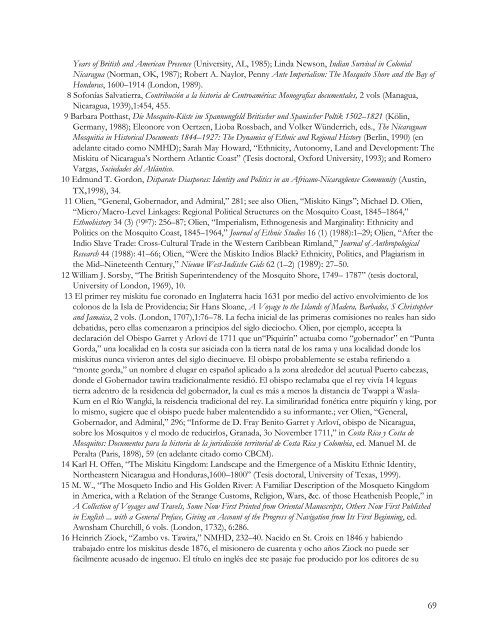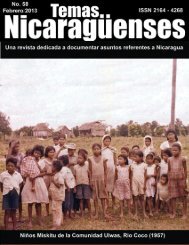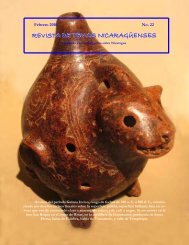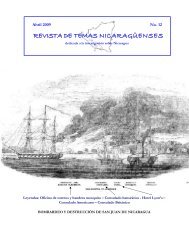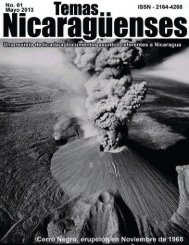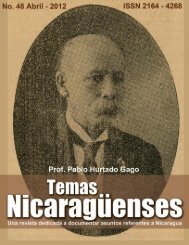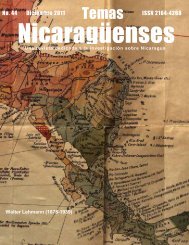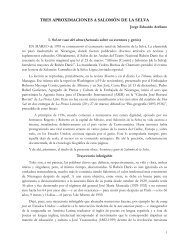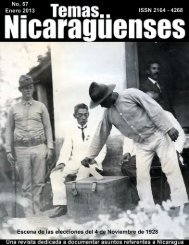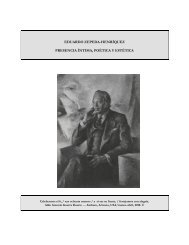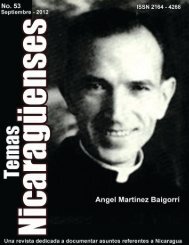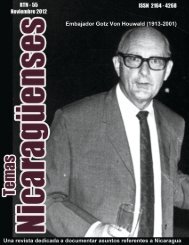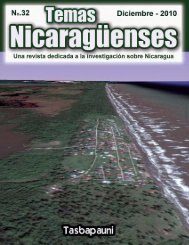21 - Revista de Temas Nicaragüenses
21 - Revista de Temas Nicaragüenses
21 - Revista de Temas Nicaragüenses
You also want an ePaper? Increase the reach of your titles
YUMPU automatically turns print PDFs into web optimized ePapers that Google loves.
Years of British and American Presence (University, AL, 1985); Linda Newson, Indian Survival in Colonial<br />
Nicaragua (Norman, OK, 1987); Robert A. Naylor, Penny Ante Imperialism: The Mosquito Shore and the Bay of<br />
Honduras, 1600–1914 (London, 1989).<br />
8 Sofonías Salvatierra, Contribución a la historia <strong>de</strong> Centroamérica: Monografias documentales, 2 vols (Managua,<br />
Nicaragua, 1939),1:454, 455.<br />
9 Barbara Potthast, Die Mosquito-Küste im Spannungfeld Britischer und Spanischer Poltik 1502–18<strong>21</strong> (Kölin,<br />
Germany, 1988); Eleonore von Oertzen, Lioba Rossbach, and Volker Wün<strong>de</strong>rrich, eds., The Nicaraguan<br />
Mosquitia in Historical Documents 1844–1927: The Dynamics of Ethnic and Regional History (Berlin, 1990) (en<br />
a<strong>de</strong>lante citado como NMHD); Sarah May Howard, “Ethnicity, Autonomy, Land and Development: The<br />
Miskitu of Nicaragua’s Northern Atlantic Coast” (Tesis doctoral, Oxford University, 1993); and Romero<br />
Vargas, Socieda<strong>de</strong>s <strong>de</strong>l Atlántico.<br />
10 Edmund T. Gordon, Disparate Diasporas: I<strong>de</strong>ntity and Politics in an Africano-Nicaragüense Community (Austin,<br />
TX,1998), 34.<br />
11 Olien, “General, Gobernador, and Admiral,” 281; see also Olien, “Miskito Kings”; Michael D. Olien,<br />
“Micro/Macro-Level Linkages: Regional Political Structures on the Mosquito Coast, 1845–1864,”<br />
Ethnohistory 34 (3) ( 19 87): 256–87; Olien, “Imperialism, Ethnogenesis and Marginality: Ethnicity and<br />
Politics on the Mosquito Coast, 1845–1964,” Journal of Ethnic Studies 16 (1) (1988):1–29; Olien, “After the<br />
Indio Slave Tra<strong>de</strong>: Cross-Cultural Tra<strong>de</strong> in the Western Caribbean Rimland,” Journal of Anthropological<br />
Research 44 (1988): 41–66; Olien, “Were the Miskito Indios Black? Ethnicity, Politics, and Plagiarism in<br />
the Mid–Nineteenth Century,” Nieuwe West-Indische Gids 62 (1–2) (1989): 27–50.<br />
12 William J. Sorsby, “The British Superinten<strong>de</strong>ncy of the Mosquito Shore, 1749– 1787” (tesis doctoral,<br />
University of London, 1969), 10.<br />
13 El primer rey miskitu fue coronado en Inglaterra hacia 1631 por medio <strong>de</strong>l activo envolvimiento <strong>de</strong> los<br />
colonos <strong>de</strong> la Isla <strong>de</strong> Provi<strong>de</strong>ncia; Sir Hans Sloane, A Voyage to the Islands of Ma<strong>de</strong>ra, Barbados, S Christopher<br />
and Jamaica, 2 vols. (London, 1707),1:76–78. La fecha inicial <strong>de</strong> las primeras comisiones no reales han sido<br />
<strong>de</strong>batidas, pero ellas comenzaron a principios <strong>de</strong>l siglo dieciocho. Olien, por ejemplo, accepta la<br />
<strong>de</strong>claración <strong>de</strong>l Obispo Garret y Arloví <strong>de</strong> 1711 que un“Piquirín” actuaba como “gobernador” en “Punta<br />
Gorda,” una localidad en la costa sur asiciada con la tierra natal <strong>de</strong> los rama y una localidad don<strong>de</strong> los<br />
miskitus nunca vivieron antes <strong>de</strong>l siglo diecinueve. El obispo probablemente se estaba refiriendo a<br />
“monte gorda,” un nombre d elugar en español aplicado a la zona alre<strong>de</strong>dor <strong>de</strong>l acutual Puerto cabezas,<br />
don<strong>de</strong> el Gobernador tawira tradicionalmente residió. El obispo reclamaba que el rey vivía 14 leguas<br />
tierra a<strong>de</strong>ntro <strong>de</strong> la resi<strong>de</strong>ncia <strong>de</strong>l gobernador, la cual es más a menos la distancia <strong>de</strong> Twappi a Wasla-<br />
Kum en el Río Wangki, la reis<strong>de</strong>ncia tradicional <strong>de</strong>l rey. La similiraridad fonética entre piquirín y king, por<br />
lo mismo, sugiere que el obispo pue<strong>de</strong> haber malentendido a su informante.; ver Olien, “General,<br />
Gobernador, and Admiral,” 296; “Informe <strong>de</strong> D. Fray Benito Garret y Arloví, obispo <strong>de</strong> Nicaragua,<br />
sobre los Mosquitos y el modo <strong>de</strong> reducirlos, Granada, 3o November 1711,” in Costa Rica y Costa <strong>de</strong><br />
Mosquitos: Documentos para la historia <strong>de</strong> la jurisdicción territorial <strong>de</strong> Costa Rica y Colombia, ed. Manuel M. <strong>de</strong><br />
Peralta (Paris, 1898), 59 (en a<strong>de</strong>lante citado como CBCM).<br />
14 Karl H. Offen, “The Miskitu Kingdom: Landscape and the Emergence of a Miskitu Ethnic I<strong>de</strong>ntity,<br />
Northeastern Nicaragua and Honduras,1600–1800” (Tesis doctoral, University of Texas, 1999).<br />
15 M. W., “The Mosqueto Indio and His Gol<strong>de</strong>n River: A Familiar Description of the Mosqueto Kingdom<br />
in America, with a Relation of the Strange Customs, Religion, Wars, &c. of those Heathenish People,” in<br />
A Collection of Voyages and Travels, Some Now First Printed from Oriental Manuscripts, Others Now First Published<br />
in English ... with a General Preface, Giving an Account of the Progress of Navigation from Its First Beginning, ed.<br />
Awnsham Churchill, 6 vols. (London, 1732), 6:286.<br />
16 Heinrich Ziock, “Zambo vs. Tawira,” NMHD, 232–40. Nacido en St. Croix en 1846 y habiendo<br />
trabajado entre los miskitus <strong>de</strong>s<strong>de</strong> 1876, el misionero <strong>de</strong> cuarenta y ocho años Ziock no pue<strong>de</strong> ser<br />
fácilmente acusado <strong>de</strong> ingenuo. El título en inglés <strong>de</strong>e ste pasaje fue producido por los editores <strong>de</strong> su<br />
69


